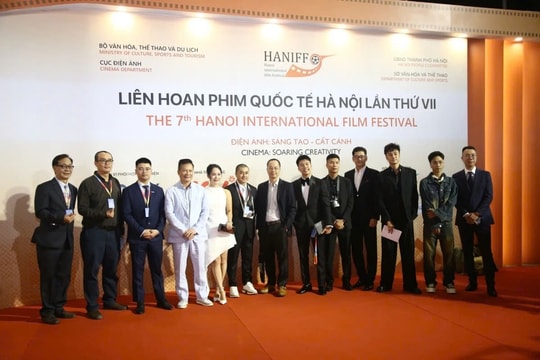| Art space inside the Hàng Đậu Water Tower. The old industrial heritage now has become an attraction for tourists since it still retains the characteristic ancient architecture of the old Hà Nội. VNA/VNS Photo |
HÀ NỘI After a boom of urbanisation resulted in less land funding for public spaces, the appearance of creative cultural complexes on former industrial sites has helped revitalise vacant buildings in Hà Nội, creating new entertainment products and services as well as infrastructure for cultural development in the capital city.
Since Hà Nội joined the UNESCO Creative Cities Network in 2019, it has required more space for art and creativity.
The city has implemented several plans to promote creative design activities in the cultural, economic and social spheres, drawing in many residents as well as international social organisations and businesses.
| The old industrial heritage of Hàng Đậu Water Tower in the old quarter of Hà Nội. It was built in a cylindrical shape, about 19m in diameter and more than 25m in height. VNA/VNS Photo |
These cultural activities have helped create a harmonious connection between the city's structures and its residents, contributing to all aspects of the daily lives of Hanoians.
Among the most successful activities is an initiative to renovate and convert old industrial facilities -- like former factories and construction sites -- into creative hubs, turning them into valued cultural heritage spaces.
A policy of relocating old production lines outside of the capital has also opened up opportunities for former industrial factories to change their functions.
| An artistic creation inside the Hàng Đậu Waterr Tower in central Hà Nội. VNA/VNS Photo |
Creative designs associated with the digital transformation are increasingly receiving attention from the community, while authorities and many businesses have discovered the benefits of investments in these old industrial sites. Hà Nội is considered a success story in pioneering a pilot revitalisation project to uphold these facilities as cultural resources.
In just a short time, old locations in the inner city -- like the Gia Lâm Railway Factory, the Trade Union Printing Factory and the Hàng Đậu Water Tower -- have been turned into artistic spaces, showing the potential of multi-functional entertainment complexes and cultural tourism destinations. These spaces can be combined with performing arts for education on history and culture that is suitable for many of the city's schools as well.
| A performance space on the train route from Hà Nội Railway Station to Gia Lâm Railway Factory. Photo hanoimoi.vn |
Hà Nội has actually seen more than a few examples of factories converted into creative spaces over the past few years. Complex 01 on Tây Sơn Street, for example, is a community cultural centre rebuilt on the foundation of the Trade Union Printing Factory, while the 282 Workshop on Phú Viên Street was built in an old conical hat factory in Long Biên District.
Although investment and renovation of these centres has been small-scale, spontaneous, and faced many difficulties due to lack of support policies and experience in strategic development, these reused spaces have helped form the first creative communities -- a highlight in urban areas.
According to research by architect Dr Đinh Thị Hải Yến, Hà Nội currently has about 185 industrial sites, of which 95 still exist while the rest have been destroyed or converted for other purposes.
| A work by sculptor Nguyễn Mạnh Hùng displayed in the last culpture exhibition "Kiến" (Ant)at workshop 3B2 in Gia Lâm Railway Factory. VNA/VNS Photo Tuấn Đức. |
Those built before 1945 include Hà Nội Beer Factory, Hà Nội Wine Factory, Yên Phụ Power Plant and Gia Lâm Railway Factory. There are also 24 factories that were built between 1954 and 1965, 12 others that were built from 1965 to 1975, and 10 built between 1975 and 1986.
“Industrial heritage sites always contain historical, aesthetic and social imprints. Many heritage sites have become very valuable for local people, since they are attached to their subconsciousness, memories and nostalgia for old times. Therefore, industrial heritage sites still have that vitality, even in modern life,” Yến was quoted as saying in Hà Nội Mới (New Hà Nội) newspaper.
According to Dr Vương Hải Long from the Hà Nội University of Architecture, the capital city's industrial heritage sites are regarded as great assets in urban construction.
"The problem is how to use these assets to benefit the people without losing their historical value. This needs to be evaluated and planned with a vision," said Long.
| Young people gather for a music art programme at the creative centre - the Complex 01. Photo courtesy of the Complex 01 |
The architect told Hà Nội Mới that many industrial heritage sites in the city have disappeared and been replaced by new construction.
He said that is an inevitable change under the pressure of urbanisation and socio-economic development.
"However, now is the time to respond properly to our industrial heritage sites," he added.
If all old industrial sites were turned into new buildings and new urban areas, they would soon be erased, and there would be nothing left to remind younger generations about the history, production and businesses of the past.
Long emphasised the necessity for measures and planning to effectively use and preserve industrial heritage sites in Hà Nội.
"We need to have a roadmap for planning to change the functions of old buildings and factories to meet the demands of modernity, and ensure that traces and memories of the history and culture of the sites are still preserved," Long said.
The concept of industrial heritage has been clearly defined internationally. It consists of the remains of industrial culture, including buildings, workshops, mills and factories, mines and sites for processing and refining, warehouses and stores, places where energy is generated, transmitted and used, transport and all its infrastructure, as well as places used for social activities related to industry.
Industrial heritage is an inseparable part of cultural heritage in general, closely tied to each historical stage of the world's industrial civilisation. These sites carry great value and significance in terms of history, society, science and aesthetics.
Hà Nội's industrial heritage consists of factories and workshops dating back to the French colonial period and during the build-up of socialism in the North. They are not merely architectural works, but also serve as vivid testimony to a challenging period in the nation's history. VNS
























